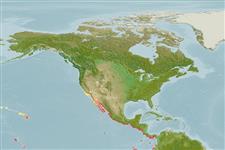Environment: milieu / climate zone / depth range / distribution range
Ecologia
marinhas; Água doce; estuarina demersal; pH range: 7.5 - 9.5; anfídromo (Ref. 51243); intervalo de profundidade 1 - ? m. Subtropical; 25°C - 33°C (Ref. 36880); 41°N - 0°S
Eastern Pacific: Palos Verdes in southern California, USA to Peru.
Comprimento de primeira maturação / Tamanho / Peso / Idade
Maturity: Lm ?, range 17 - ? cm
Max length : 41.0 cm TL macho/indeterminado; (Ref. 5404); 39.0 cm TL (female); common length : 25.0 cm TL macho/indeterminado; (Ref. 55763); peso máx. publicado: 1.2 kg (Ref. 5404); peso máx. publicado: 1.2 kg
Descrição suscinta
Chaves de identificação | Morfologia | Morfometria
Body compressed; head flat; first dorsal fin with 7 spines, second with 1 spine and 8 to 9 rays; anal fin with 1 spine and 9 to 10 rays; lateral line with 30 to 34 scales; body depth contained about three times in standard length; body dark green to dark brown with numerous small pale spots (Ref. 55763).
Facultative air-breathing (Ref. 126274); Inhabit estuaries, stagnant ditches or creeks of low current velocity between the sea and an elevation of 30 m. Benthic and most abundant on sandy and muddy bottoms. Ingests much mud and detritus, although also filter plankton (Ref. 36880). Found in shallow inshore areas; typically in freshwater but moves freely into the sea.
Ciclo de vida ou comportamento de acasalamento
Maturidade | Reprodução | Desova | Ovos | Fecundidade | Larvas
Eschmeyer, W.N., E.S. Herald and H. Hammann, 1983. A field guide to Pacific coast fishes of North America. Boston (MA, USA): Houghton Mifflin Company. xii+336 p. (Ref. 2850)
Status na Lista Vermelha da UICN (Ref. 130435: Version 2024-2)
Ameaça para os humanos
Harmless
Uso pelos humanos
Pescarias: espécies comerciais; Aquacultura: espécies comerciais
Ferramentas
Relatórios especiais
Baixar XML
Fontes da internet
Estimates based on models
Preferred temperature (Ref.
123201): 22.3 - 29.1, mean 26.8 °C (based on 208 cells).
Índice de diversidade filogenética (Ref.
82804): PD
50 = 0.5312 [Uniqueness, from 0.5 = low to 2.0 = high].
Bayesian length-weight: a=0.01023 (0.00757 - 0.01383), b=3.11 (3.03 - 3.19), in cm total length, based on LWR estimates for this species (Ref.
93245).
Nível Trófico (Ref.
69278): 2.0 ±0.0 se; based on diet studies.
Generation time: 1.9 ( na - na) years. Estimated as median ln(3)/K based on 1
growth studies.
Resiliência (Ref.
120179): Elevada, tempo mínimo de duplicação da população menor que 15 meses (K=0.57).
Fishing Vulnerability (Ref.
59153): Low to moderate vulnerability (25 of 100).
Nutrients (Ref.
124155): Calcium = 118 [54, 257] mg/100g; Iron = 1.24 [0.59, 2.45] mg/100g; Protein = 18.7 [16.7, 20.4] %; Omega3 = 0.278 [0.165, 0.480] g/100g; Selenium = 20.8 [10.3, 46.6] μg/100g; VitaminA = 7.09 [2.13, 23.95] μg/100g; Zinc = 1.28 [0.88, 2.08] mg/100g (wet weight);
